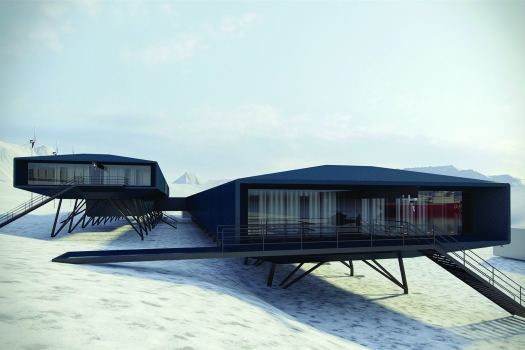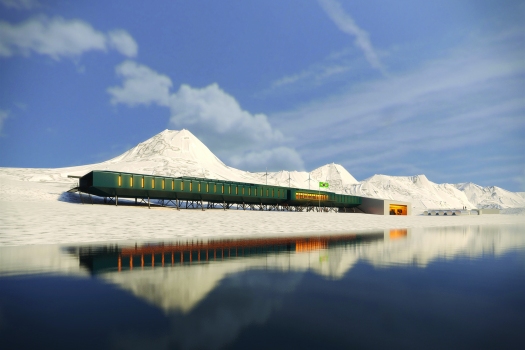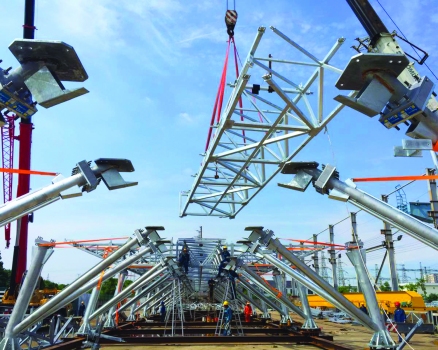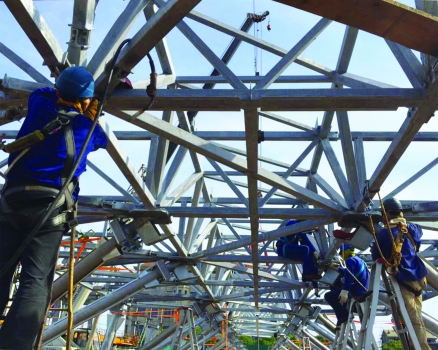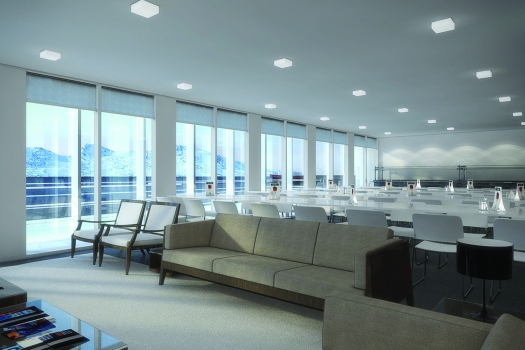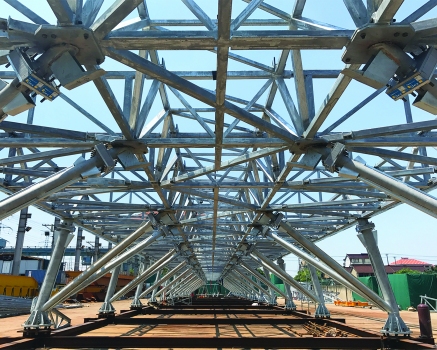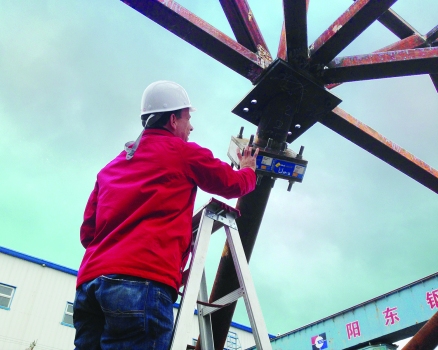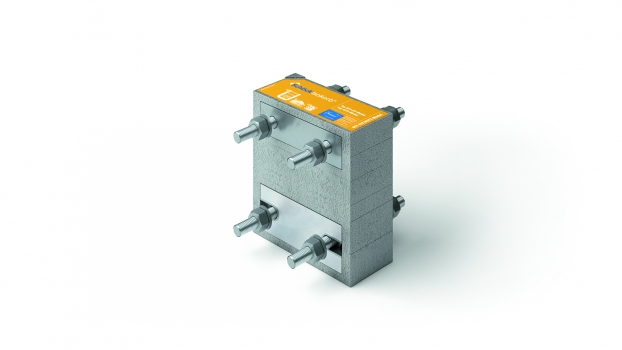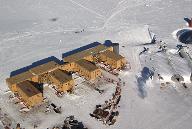New Antarctic Station insulated from frigid environment using structural thermal breaks
1,000 km south of South America new Comandante Ferraz Antarctic Station is being built at a cost of around 82 million Euro. The Brazilian Navy operates the research outpost on behalf of the Brazilian Science and Technology Ministry. The futuristic station is to be completed by the end of 2018. It's 3,200 m² of space will provide a safe environment for scientific research and comfortable living. Thermal insulation ensures that even in the most adverse temperature conditions the heat will not be transferred from the interior steel structure to the outer steel piers.
Media
Technically advanced design yields a comfortable platform for scientific study in the world’s most inhospitable environment
The futuristic Comandante Ferraz Antarctic Station employs structural thermal breaks to prevent its warm interior steel structure from dissipating heat through steel pillars exposed to sub-zero temperatures and high winds. Commissioned and maintained by the Brazilian Navy for the Brazilian Science and Technology Ministry, the €82 million ($100 million) Comandante Ferraz Antarctic Station (EACF) is a scientific research outpost that will be located 1,000 km (600 miles) south of the tip of South America. Scheduled for completion in 2018, the 3,200 m² (34,000 sq ft) EACF will support technological research in a secure workspace while providing safe and comfortable living conditions. It will also minimize the impact on wildlife and the environment.
To determine the most effective design, the Brazilian Navy held an international competition in 2013, won by Estudio 41, a Brazilian architecture firm. According to Estudio 41 lead architect, Emerson Vidigal, "The design takes into consideration the challenges of supporting technological performance in such an extreme climate, while still considering the facility's aesthetics, offering a comfortable and secure workspace. Taking into account the topography of its site, we created a design that minimizes impacts on surrounding wildlife and plant life in the immediate environment, while providing an optimum work and living space."
The design divides the station into two core blocks that are organized according to function. The upper block houses living quarters for 64 inhabitants including cabins, dining, and service areas. The lower block integrates central workspaces, accommodating 17 laboratories and operation and maintenance zones. Another lower level houses the central barn and garages. Additional component structures intersect and join the three component areas providing communal space including an auditorium, cybercafé, library, meeting room, and video conferencing room.
Three primary factors drove the building's exterior design: temperature, snow accumulation, and wind speed. Clad in concealed-fitting, galvanized and coated sheet steel panels with rigid polyurethane foam insulation, the façade is corrosion-resistant, low-maintenance, and highly resistant to wind, driving snow and intense cold. In addition, the EACF is fabricated in elongated, streamlined, prefabricated modular sections – continuously joined and arranged linearly – to mitigate wind force. The steel structure supporting the floors consists of trusses positioned along a grid, modulated with 600 x 1200 cm (19.7 x 39 ft) panels. Latticed, vertical braces support the roofs. Walls are placed at a maximum of 12 m (39 ft) apart. All of these components sit atop a system of steel pillars, which transfer the load of the building onto the ice.
To mitigate what may be the most extreme example of thermal bridging on earth, the project team is deploying 218 Schöck Isokorb® structural thermal breaks (STBs) between the building's interior steel-framing and its exterior steel support pillars and staircases.
What thermal bridging is and why it matters
Thermal bridging typically occurs where structural steel beams or cast concrete penetrate an insulated building envelope. These penetrations conduct heat from interior support structures through the envelope, dissipating it into the exterior environment with three deleterious effects:
- Energy waste and carbon emissions,
- Cold interior walls and floors reducing occupant comfort and
- Chilled interior surfaces adjacent to penetrations forming condensation, causing structural steel to rust and the potential for mold growth.
Though problematic in any environment, thermal bridging consequences can prove particularly severe in Antarctica due to extreme interior-exterior temperature differentials and the difficulty of remediating such problems in a harsh and isolated location.
STBs provide a thermal break and maintain structural integrity
"To ensure that the building remains fully insulated from the outside, it was necessary to use thermal breaks in the connections of the raised structure to the steel columns in contact with the ground,"
explains Afaconsult project engineer Rui Furtado. "We chose Isokorb® STBs because they are multidisciplinary elements. First, they are a thermally insulated component, guaranteeing the continuity of the insulation even in the points in contact with the outside, as is the case with most of the column supports of the structure to the ground. It is, therefore, possible to have the building completely insulated from exterior to interior."
"The STBs connect the steel structure and withstand shear forces, tensile/traction, and pressure absorption, while dramatically reducing thermal energy loss. Another advantage corresponds to their modular construction. They work with all steel types and profiles and are constructed from non-rusting stainless steel, offering long-lasting corrosion protection. I also want to acknowledge the technical support given by Schöck, which was essential for this process"
, says Furtado.
Utilized are Isokorb® Type S22 STBs, which are load-bearing thermal insulation elements consisting of an 80 mm (3.125 in.) thick block of HCFC-free polystyrene foam insulation held between a rectangular hollow structural section with stainless steel bolts.
Construction in the most difficult location
CEIEC, the Chinese construction firm building the EACF, is fabricating, assembling and then disassembling the structure's components before shipping them to the Antarctic site for re-assembly. Because of the site's remote location, forbidding environment and short construction window, all technical issues must be resolved prior to transport. "Not a single piece of structure can board the transporting vessel without being tested and approved"
, explains Furtado.
More than just science
In the BBC article "How Antarctic bases went from wooden huts to sci-fi chic," Polar Journal editor-in-chief Professor Anne-Marie Brady explains that "Antarctic stations have become the equivalent of embassies on the ice. They are showcases for a nation's interest in Antarctica – status symbols."
For Brazil, that status is a byproduct of the country's long-standing commitment to leading-edge environmental research for the benefit of all life on earth, reflected most recently by the EACF's state-of-the-art design, advanced components, and modular fabrication a half-world away from its destination – giving new meaning to "thinking outside the box."
References
Structure Types
Relevant Websites
- About this
data sheet - Product-ID
7616 - Published on:
16/11/2018 - Last updated on:
17/11/2021

